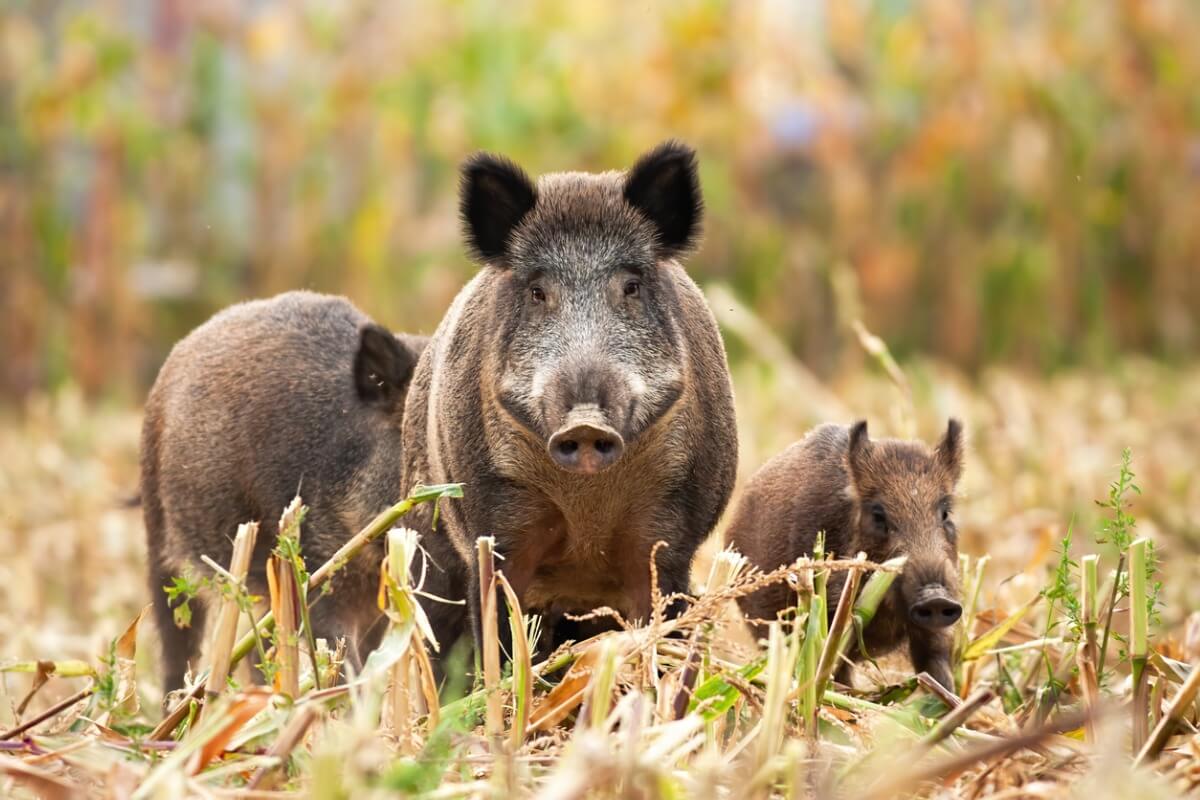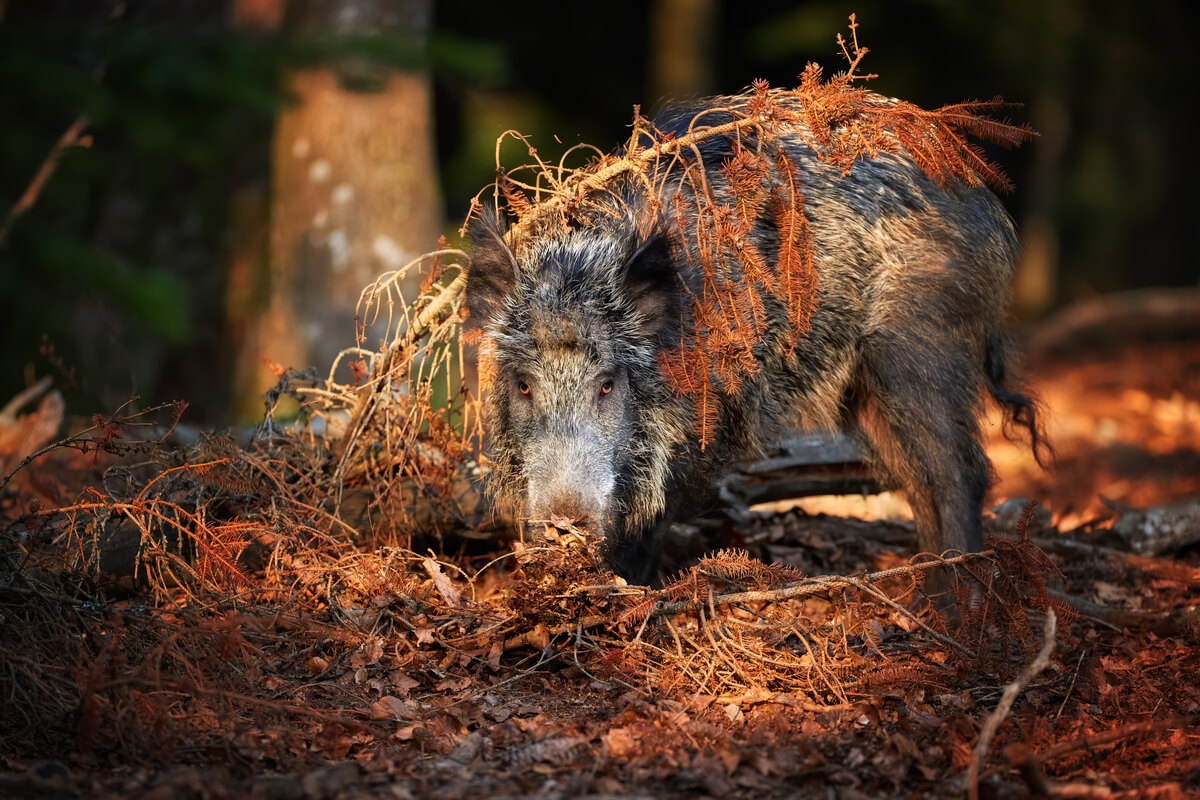What Do Wild Boars Eat?

Wild boars are wild mammals with a unique appearance and are distributed almost worldwide, either naturally or as introduced species. However, as exotic animals, they’re a big problem, as they devastate everything in their path due to their feeding habits. For these reasons and many more, you may be interested to know what wild boars eat.
There are different species of Suidae, although the best-known one, which the domestic pig comes from, is the European or Common wild boar (Sus scrofa). Their diet is very varied, so read on to find out more about them in detail.
Wild boar characteristics
The wild boar is a medium-sized mammal of between 90 and 160 centimeters in length (3 to 5 feet), weighing up to 150 kilograms (330 pounds). Females tend to have less body mass than males. They weigh between 40 and 70 kilograms (88 to 155 pounds), while the males range from 70 to 100 kilograms (155 to 220 pounds).
The physical appearance of these animals is peculiar. They have a large head with small eyes, a thick neck, and short legs with hooves (the front pair is higher than the hind pair). Their skin is hard and covered with thick, long black, grey, brown, or even reddish fur.
The wild boar is a robust animal whose appearance inspires a certain fear or respect.
In addition, these mammals are characterized by how easy it is for them to adapt to diverse environments, as long as food and water are available. However, they prefer places with vegetation that can provide them with some camouflage, such as holm oak groves, deciduous forests, thickets, and marshes. Their skin and fur allow them to resist the cold winters.
Water resources are indispensable, not only for drinking but also for regulating its body temperature, which is why it is common to see wild boars taking a refreshing bath in the mud.

What kind of food do wild boars eat?
Wild boars have a heterogeneous diet, composed of both plant and animal organisms, so they cover a wide trophic spectrum. Because of this, they’re considered to be omnivores. Their menu is characterized by its variability, according to the geographical location and the season of the year. They tend to increase their consumption during the winter, as this is how they prepare themselves to withstand the cold.
This animal knows how to take advantage of the resources available at each time of the year and in the particular ecosystems it occupies, consuming any type of food available.
The food preference of wild boars leans towards plants. However, some researchers claim that their stomach can assimilate only 30% of protein from this source (as they aren’t ruminants). Because of this, they need to supplement their diet with animal meat. Let’s have a look at what wild boars eat in a little more detail.
What vegetables do wild boars eat?
The vegetables consumed by wild boars are quite varied, and they also eat different plant parts. They can eat roots, rhizomes, twigs, branches, bark, leaves, fruits, seeds, and shoots. They also include fungi, mosses, and lichens in their menu.
Among the types of plants and trees these mammals like, we can include leguminous plants, oaks, beeches, chestnuts, grasses, and others. They also love acorns and beechnuts. In some places, wild boars feed on agricultural products, and this can cause big problems and conflicts with humans.
What animals do wild boars eat?
Regarding their prey, their intake is also varied. They consume small vertebrate species, some reptiles, amphibians, birds, eggs, and mammals such as rodents, among others. Wild boars also feed on invertebrates, especially crabs, worms, insects, and mollusks.
An important part of their diet is carrion, as wild boars take advantage of any dead animal they find in their path. The species they eat vary according to geographical location and habitat. For example, according to one study, wild boars in northern Spain supplement their diet with dead dogs, rabbits, roe deer, and field mice.
What do baby boars eat?
It’s to be expected that, at first, baby boars feed on their mother’s milk. At the start, they do so exclusively, specifically during the first 3 weeks. After this time, the feeding becomes mixed, as they alternate breastfeeding with solid food. Weaning takes place after 4 months.
How do wild boars get their food?
Despite having a robust body, these pigs are agile when it comes to getting their food, as they use their snout and hooves to dig under the ground. In addition, although they don’t see very well, they have other better-developed senses, such as smell and hearing, which they use to help them find their food.
When they dig in the ground, swine leave the typical marks called “sickle marks”. With this practice they cause extensive damage to crops. Wild boars dig in the soil, not only in search of roots and tubers, but also to find any appetizing invertebrates (such as earthworms).
Other curiosities about how wild boars eat
Here is some other interesting information related to the feeding of these mammals:
- Adult wild boars have a total of 44 teeth, 22 in each jaw. The teeth are as follows: 6 incisors, 2 canines, 8 premolars, and 6 molars per jaw. The tusks are the most prominent, especially in males.
- The young have fewer teeth (28 in total) and these are deciduous. They have all their teeth at around 3 or 4 months old.
- The reproduction of these wild pigs is related to their health and condition and so they’re more likely to reproduce when there’s plenty of food.
- The first ovulation of a wild boar occurs when they reach a minimum weight of 30 kilograms (66 pounds), at 11 months of age. In Mediterranean environments, this period coincides with acorn season. In other places where food is more scarce, ovulation may be delayed until better conditions are found.
- The fecundity of females also depends in part on their body mass, and so, here too, there is a close link to food. Heavier wild boars have more offspring than the lighter ones.
- Pregnant females tend to browse more frequently than males and other non-pregnant females.
- Water is very important to a wild boar and it needs to drink plenty of it. This is due to the type of diet it has, which is predominantly dry.

In short, wild boars have a very diverse diet, and they adjust their diet very astutely, based on habitat and time of year. In addition to this, they achieve the right nutritional intake by getting the right balance between plant and animal food, an ingenious solution for their robust body.
All cited sources were thoroughly reviewed by our team to ensure their quality, reliability, currency, and validity. The bibliography of this article was considered reliable and of academic or scientific accuracy.
- Fernández-Llario, P. (2014). Jabalí-Sus scrofa Linnaeus, 1758. En: Enciclopedia virtual de los vertebrados españoles. Salvador, A., Luque-Larena, J. (Eds.). Museo Nacional de Ciencias Naturales, Madrid. http://www.vertebradosibericos.org/
- Sáenz, M. (1995). Alimentación del jabalí (Sus scrofa castillanus) en el norte de España. Ecología, 9, 367-386.
- Skewes, O., Rodríguez, R., & Jaksic, F. (2007). Ecología trófica del jabalí europeo (Sus scrofa) silvestre en Chile. Revista Chilena de Historia Natural, 80, 295-307.
This text is provided for informational purposes only and does not replace consultation with a professional. If in doubt, consult your specialist.